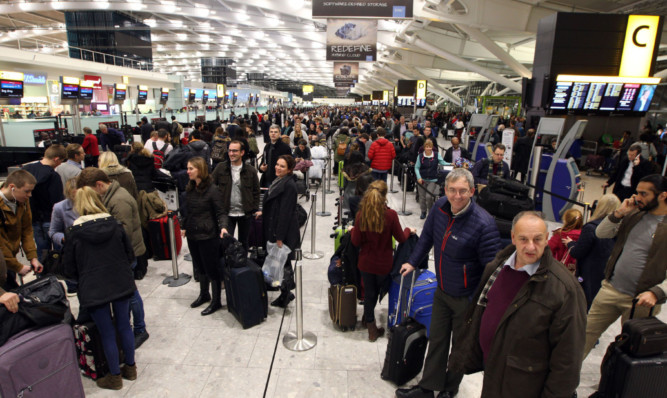
Flight chiefs have said they aren’t expecting any problems during the big Christmas getaway this week.
Air Traffic controllers said they have fixed a technical glitch which led to widespread disruption at airports around the country and have “confidence” in their computer systems ahead of one of the busiest travel periods of the year.
A spokesperson for National Air Traffic Services (NATS) said they did not expect any problems this weekend.
They said: “We are confident in all of our systems.”
The vow was made as millions of passengers prepare to jet off around Britain and the world to spend Christmas with loved ones.
Flights were expected to be back to normal today after chaos caused by a technical fault in the national air traffic control centre.
The issue caused problems at airports around southern England and as far north as Edinburgh and Aberdeen on Friday, after the failure in the flight data system in Swanwick, Hampshire.
Hundreds of flights were delayed or cancelled, with no aircraft able to take off at all for a time at some of the UK’s biggest airports.
Yesterday, a further 38 flights were cancelled at Heathrow as it cleared the backlog. The airport said there remained some knock-on effects yesterday due to aircraft “being out of position” and advised travellers to check their flight status.
However, with just days to go until Christmas, airports around the UK expected flights to be running on schedule today.
NATS launched an investigation and said it had gained a clearer understanding of what went wrong and apologised again for inconvenience to passengers. It said the unprecedented failure occurred during transition between the workstations in use by controllers and those on standby.
A spokesperson said: “The failure meant that the controllers were unable to access all of the data regarding individual flight plans, which significantly increases their workload.
“Our priority is to maintain a safe operation for the flying public; consequently when the failure occurred we immediately took steps to reduce the traffic into and out of the UK network.
“At no time was safety compromised in any way.”
The glitch lasted just 45 minutes but caused a massive backlog in take-offs and landings.
Passengers queued for hours to book on to alternative flights and many had to stay in hotels overnight. This week is traditionally one of the busiest for UK airports.
More than 631,000 passengers are expected to pass through Heathrow alone from Friday to Sunday.
Edinburgh Airport is preparing to handle a record number of passengers.
Transport Secretary Patrick McLoughlin will be questioned by MPs tomorrow about the chaos caused. He has already described the collapse as “unacceptable” and asked for a full explanation from NATS about what had gone wrong and what it would do to prevent such an incident happening again.
Labour chairwoman of the transport select committee, Louise Ellman, said it was: “vital that we establish what happened”.
She said her committee will call NATS and the Civil Aviation Authority to give evidence.
Last night it also emerged thousands of flyers caught up in this week’s chaos may not be able to claim compen-sation. Airlines can reject compensation claims if flights are grounded due to “extraordinary circumstances” a get-out clause which could leave many out of pocket.
It was not the first time Swanwick, which cost £623m to build and controls 200,000 square miles of airspace above England and Wales, has been hit by problems.
Flights were affected by technical problems and computer faults in 2008 and last summer. Those delays were caused by a telephone system hitch.

Enjoy the convenience of having The Sunday Post delivered as a digital ePaper straight to your smartphone, tablet or computer.
Subscribe for only £5.49 a month and enjoy all the benefits of the printed paper as a digital replica.
Subscribe